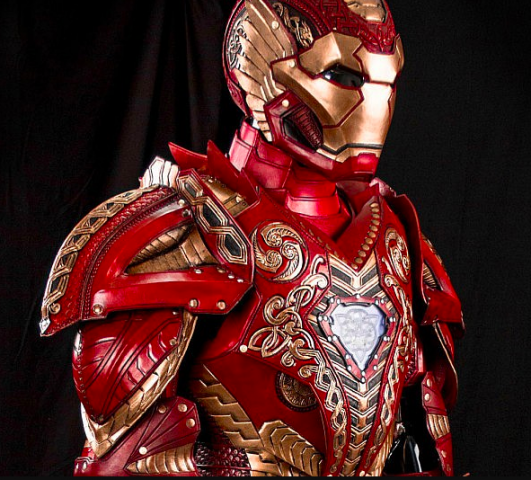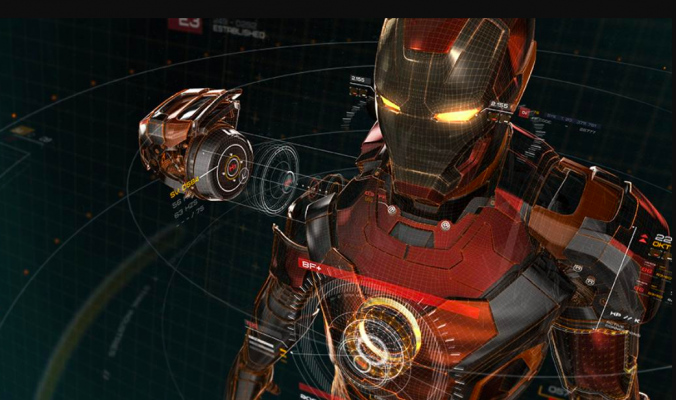 RobotRepublic — We are always pushing the extraordinary machine that is the human body to new extremes. And we’ve been doing that for centuries.
RobotRepublic — We are always pushing the extraordinary machine that is the human body to new extremes. And we’ve been doing that for centuries.
Think about it: We have invented flying machines, developed new medicines, built advanced computing devices and launched rockets into space, testing the mental and physical resolve of the human body.
We have run faster and further, jumped higher and longer, climbed the highest mountains and swam to the depths of the oceans.
We are astonishing. We are truly super. But we are not superheroes.
As Hollywood has reminded us again and again in recent years, superheroes have something extra. But rather than cow us, they remind us of all the amazing feats we have yet to master. And they are coming, though not soon enough.
In June of this year, a group of scientists and industrial proponents outlined Genome Project-Write in the journal Science, a project with the principal aim of building a fully synthetic human genome.
Although this project could have positive implications for drug development and gene therapy, those central to the project envisage the possibility of creating a generation of fully synthetic humans, more advanced than current humans. Initial forecasts suggest that it might require $100 million and at least 10 years just to kick-start the project.
As a result Genome Project-Write could be years from creating superhumans in the true sense of the word.
But do we have already the biological and technological means to create superheroes with superpowers? The answer to that question is yes — an emphatic yes. We are getting closer and closer to a reality in which we are the superheroes.
Here’s how our progress toward such a superpower world is unfolding …
CRISPR/CAS X-MEN
>
In X-Men: Apocalypse, after waking from an entombment of thousands of years, the immortal Apocalypse (En Sabah Nur) is shocked at the choices humans make and the paths they’ve taken. Humankind has lost its way, he believes.
And naturally, he holds that human society needs a radical reshaping — and that he is the one to bring that about.
 Now, Apocalypse is seen by many as the first mutant in the X-Men Universe and therefore the first to carry the X-Gene, the genetic code central to the powers of the X-Men. Without the X-Gene, Professor Xavier wouldn’t have his incredible telepathic powers, Wolverine wouldn’t have the ability to rapidly self-heal and Cyclops wouldn’t be able to shoot energy blasts from his eyes.
Now, Apocalypse is seen by many as the first mutant in the X-Men Universe and therefore the first to carry the X-Gene, the genetic code central to the powers of the X-Men. Without the X-Gene, Professor Xavier wouldn’t have his incredible telepathic powers, Wolverine wouldn’t have the ability to rapidly self-heal and Cyclops wouldn’t be able to shoot energy blasts from his eyes.
Thanks to the Human Genome Project (HGP), we have identified all of the genes in our DNA. When expressed in the body, genes can lead to the production of RNA and proteins such as collagen and haemoglobin.
But what if we somehow managed to synthetically create an “X-Gene?” That would essentially grant us superpowers by coding it right into our DNA?
The answer is yes — and the tool is known as the CRISPR/Cas system.
Adapted from the defense mechanisms of bacteria, the method can be used to “slice” or “cut” DNA at targeted locations. After cutting, it is possible to insert a new gene such as the X-Gene behind Wolverine’s accelerated healing powers. However the tool can also be used to disrupt or destroy those genes that may lead to future ailments or diseases.
Although CRISPR/Cas has been used to genetically modify crops and zebrafish, it will be some time before the method is used to genetically modify the human genome. There are ethical, financial, scientific, religious and societal issues that must be addressed before the CRISPR/Cas method is widely implemented.
In the meantime? We’ll just have to make do with the edited mushrooms that don’t brown or zebrafish that now grow limbs rather than fins. But if the world accepts the process as a safe and reliable method for genome editing, we may very well be able to engineer the X-Men.
NOW YOU SEE ME, NOW YOU DON’T
While genetic editing provides a viable path towards biologically engineered superpowers, it may be years before the first X-Men-like people appear in the real world. But rather than choosing a genetic-editing path, there is a considerable possibility that modern technological research projects will yield superpower-like gadgets  sooner rather than later.
sooner rather than later.
The power of invisibility has been the subject of a number of science fiction adventures since H.G. Wells’ 1897 book The Invisible Man. Invisibility has played a part in Harry Potter films, the 2004 film The Incredibles and the 2000 science fiction film Hollow Man starring Kevin Bacon.
However, long before Harry Potter came to Hollywood, Stan Lee and Jack Kirby at Marvel Comics gifted one of their most famous characters with the power of invisibility – Sue Storm.
Also known as the Invisible Woman, Sue is part of the dynamic superhero team The Fantastic Four, battling villains such as Doctor Doom or Galactus.
The key to making anything invisible is to prevent reflected light from the object from entering our eyes. If the light doesn’t reach our eyes then the rods and cones in the retina, which is located at the back of the eye, won’t be able to produce electrical and chemical impulses that are interrupted by the brain to form an image.
Transformation optics is the field of research dedicated to development of invisibility technologies and researchers are investigating a number of materials that could be used to create an invisibility cloak.
For example some researchers are fabricating artificial materials known as metamaterials that can be used to bend light around objects. The key to the functionality of many of these materials is that they possess a negative index of refraction, a property that’s not found in the natural world.
These metamaterials work well for long wavelength sources such as microwaves.
However, as the wavelength decreases towards the visible spectrum it becomes more and more difficult to manufacture structures comprised of such metamaterials, materials that are able to bend visible light.
In this vein, some researchers have turned to calcite crystals to create invisibility technologies while two researchers at the University of Rochester have taken a simpler, and quite novel, path towards invisibility.
Joseph Choi and John Howell have opted to build an invisibility cloak using optical lenses that can be bought for less than £100. Yes, you could build an invisibility cloak at home.
PRODUCING SPIDER SILK
Sue Storm developed her superpowers thanks to a genetic modification caused by, depending on which comic book origin story is gospel to you, either cosmic rays or inter-dimensional travel. Note: avoid cosmic rays – these high-energy particles are more likely to kill you than give you with superpowers)
 Spider-Man is another notable Marvel character who gained their superpowers through genetic changes after his alter ego Peter Parker was bitten by a radioactive spider.
Spider-Man is another notable Marvel character who gained their superpowers through genetic changes after his alter ego Peter Parker was bitten by a radioactive spider.
After the bite, Parker develops many spider-like abilities such as wall climbing, but he also masters the production and manipulation of spider silk. Spider-Man in the 2002 film Spider-Man can naturally produce spider silk while Spider-Man in the 2012 reboot The Amazing Spider-Man constructs his own web-slingers.
Like collagen in the human body, spider silk is a protein and one of the strongest natural materials on the planet (it could comfortably stop a train for instance). Given these properties, many have envisaged using spider silk as an alternative for existing bulletproof technologies.
In fact, Dutch bio-artist Jalila Essaïdi has created a bulletproof skin that incorporates spider silk, which although won’t block bullets travelling at normal speeds, is a promising start. In addition, spider silk is being considered as an alternative material for parachutes, fishing lines and even replacement ligaments for the human body.
But how can we get access to ample amounts of spider silk? Professor Randy Lewis at Utah State University is at the forefront of mass-producing spider silk with genetically modified goats.
Spider DNA has been combined with goat DNA to create “spider-goats” that when milked, produce spider silk in their milk. It’s astounding science and a prime example of thinking outside the box.
Now that we have a way to mass-produce spider silk, a material that is many times stronger than most alloys of steel, we could, in the future, build web-slingers.
THE IRON MAN SUIT MAKES THE MAN
And then there’s Captain America: Civil War.
 Here we saw the return of Iron Man, but many contend that Iron Man isn’t a real superhero and that he just invented a suit that gives him superpowers.
Here we saw the return of Iron Man, but many contend that Iron Man isn’t a real superhero and that he just invented a suit that gives him superpowers.
It is hard to disagree with this statement but Tony Stark’s scientific and engineering developments are no different from those researchers trying to develop invisibility cloaks or spider silk bulletproof skin.
As you may recall, Stark’s invented some incredible devices over the years. But the Iron Man suit is probably his greatest invention. This is a suit that can fly about like a plane and fire all kinds of weapons from various locations.
It has has an advanced on-board computer and provides Stark with augmented protection for his body.
Without the suit Tony’d be lost. He would’e never have been able to battle Thor in The Avengers, the Hulk in Avengers: Age of Ultron or Captain America in Captain America: Civil War.
In the 2008 film Iron Man, Tony Stark reveals that the suit is made from a gold-titanium alloy.
Up until recently, the only application for this type of alloy in the real world was in dental fillings and jewelery.
But a group at Houston’s Rice University has developed a new titanium-gold alloy known as titanium-3 gold. The secret to creating the material was to mix three parts titanium with one part gold at very high temperatures.
Titanium-3 gold is about three to four times harder than most steel alloys and will most likely be in replacement joints for the human body. But now that we have the supposed alloy used by Tony Stark for the Iron Man suit, might it be time to start integrating the material with advanced exoskeletons such as the one being developed by the Japanese company Cyberdyne?
The Iron Man suit could get real — and sooner than we think.
SUPERPOWER MANAGEMENT
The battle between the eponymous heroes of Batman v Superman: Dawn of Justice was fueled by Bruce Wayne’s desire to manage superpowers, in effect to manage Superman.
It’s a drastic course of action led to their eventual cooperation, and along with Wonder Woman, they battled the fearsome Doomsday.
 Bruce Wayne made an extreme effort, for instance, to manage Superman. It paid off.
Bruce Wayne made an extreme effort, for instance, to manage Superman. It paid off.
But there’s a different outcome in Captain America: Civil War. Here we witness the introduction of the UN-led Sokovia Accords, which was set up to monitor and control the world’s superheroes.
On paper, at least, the Accords appear to be logical and well founded so far as they go. But there’s a major flaw here: They fail to account for the fractures that develop between former friends and allies, such as the relationship between Iron Man and Captain America. Their battles are turn vicious, a testament to the difficulties we will have in the future when superpower technologies become widespread.
And the point is well taken, isn’t it? We can’t sleepwalk our way into introducing superpowers to the masses. It’s going to take some serious planning and sober reflection to figure out how, when and how much superpower fits into society.
Of course we need logical controls and the ability to easily change or update these technologies without disrupting society.
If this all sounds like an exercise in unlikelihood, stop a minute. As I write, military research grants all over the world are supporting the research and development of such futuristic, superhero-inspired trappings as suits of invisibility, bulletproof garments and vehicles, even Iron Man-like exoskeletons.
The military will, of course, be the first to see such innovations. And they’ll be using them — and maybe abusing them — while the rest of the world looks on yearning to be the next superhero.
SUPER-FUTURE PLANNING
Researchers are moving straight toward the creation of superpower technologies, it will of course be a long while before we’ll be able to pick them up on Amazon or whatever has replaced it by this time.
And further out, projects like the “Genome Project-Write” foresee a biological route towards creating advanced synthetic, and possibly super, humans.
The first synthetic superhero still is a futuristic concept that seems decades away. We probably won’t live to see that. But we will be here to watch all sorts of compelling tech research moving us ever closer to super-humanhood. And if that gets too
We who crave superpowers will watch promising technological research with interest and, of course, embrace the latest cinematic superhero adventures. With films such as Avengers: Infinity Wars, Justice League, Guardians of the Galaxy 2, Wolverine 3 and Captain Marvel set for release over the coming years, there will be plenty more superhero adventures to fuel the world’s appetite for superpowers. If you do manage to get superpowers in the future, it’s imperative that you pick a catchy name and get yourself a cool costume.
Prepare yourself for superpowers because scientists are slowly, but surely, revealing the Secrets of Superhero Science.
For aNewDomain and the new RobotRepublic, I’m Barry W. Fitzgerald.
Cover image: Creators.vice.com, All Rights Reserved; Inset images: Fanpop.com, All Rights Reserved; Marvel-Movies.wikia.com. All Rights Reserved; Spiderman.wikia.com, All Rights Reserved; ThisIsWhyImBroke.com, All Rights Reserved.













